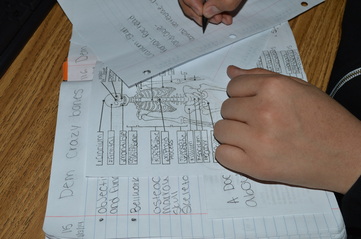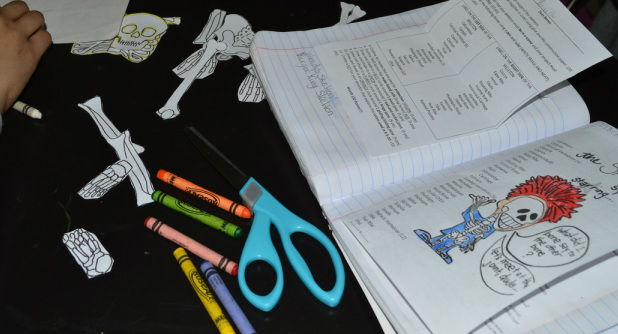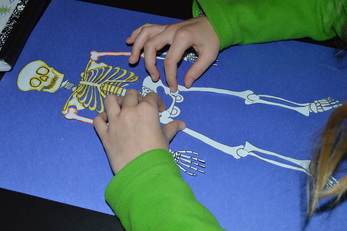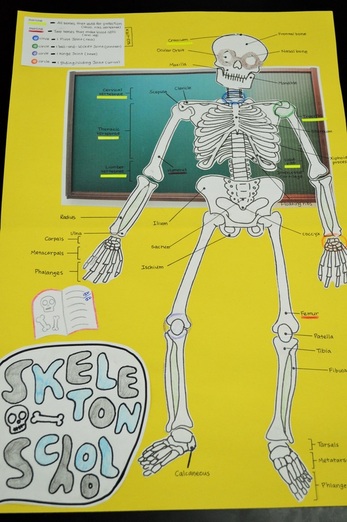There ain’t no bones about it – humans would be a big pile of muscles, skin and gooey organs if it weren’t for the skeletal system! We love teaching our human body unit from the inside out – skin, muscles, bones, and all the other systems that work in-between. Our next stop after the muscular system is the skeletal system, and here’s what we’d do to get down to the bare bones of what we’re made of:
Sponge or Bellwork: Our lessons always start with a bell-work question or activity that gets kids thinking about the topic at hand. For example:
- Give students a list of the types of joints and have them determine which joints of their body align with the various types.
- Have students brainstorm what the bones do for the body.
- Have students compare and contrast the bones of the skull with the bones of the arms and legs.
Remind them to cite evidence of their reasoning and that, while their thoughts and words are what we want them to record, options such as “I don’t know” or “because I think it is” are not acceptable answers.
Let’s Explore: To begin, have students learn about the five main functions of the skeletal system. You can do this through a visual guide like a PowerPoint, have students learn through inquiry or through class discussion.
- Structure and support for the body
- Stores and releases minerals and fats
- Protects internal organs
- Manufactures red blood cells
- Works with the muscular system to produce movement
Add to your discussion the general composition of the structure of a long bone, the cells that create and break down cells (osteoclasts and osteoblasts) and explore the various joints of the body – a great way to do this is to compare joints with common items found in your classroom, like door hinges, door knobs, etc. Talk about the purpose of cartilage and how the skeleton is comprised of mostly cartilage at birth. Students are always amazed at how the skull is formed and that it is made of so many bones. We like to watch a great video that shows students how bones grow during their adolescent years, and what happens inside the body when a bone is broken. One interesting fact that always boggles their minds is the flexibility of bones during times of stress and how quickly bones can heal.
Once you’ve completed the nuts and bolts of the skeletal system, have students learn the most common (35) bones of the body – their location, functions, scientific names, and common names. While you could have students memorize the bones, we found that a project really helped them to cement their understanding. Before the end of the class period, have students brainstorm ideas about the construction of their project. The project consists of putting the bones together in the proper order, correctly labeling the 35 bones learned in class, and color-coding and identifying the main types of joints and any bones that have special purposes.

Make it fun by having students get creative. Have them place their skeleton in a scene (a classroom, t-rex belly, ballet studio, Starbucks, etc), put clothes on their skeleton (so you can still see the bones), and even give their skeletons a name.
Did They Get It? You’ll quickly find that your favorite part of grading this project is seeing all of the incredibly creative ideas the kids come up with AND grading is a breeze because of the rubric that comes along with the project.
Here’s a few extensions for this lesson:
- Have students identify bones that were not listed in the original project as extra credit.
- Have students research which animals produce red blood cells in their bones and which do not.
- Have students calculate the percentage of long bones versus short bones, flat bones, etc.
Need to modify?
- Reduce the number of bones to be labeled or identified.
- Pre-label the bones before making copies for your students that have executive function deficits.
- Pre-cut a few templates or have a fast-cutting class mate trim a few templates for students with fine motor skill deficits.
This project is available in our Skeletal System Bundled Unit which comes complete with an animated PowerPoint presentation, skeletal system notes, joint comparison worksheet, long bone diagram, project directions, rubric, and examples!
Inspire Students. Love Teaching.
We have everything you need to successfully teach life science and biology. Join over 85,000 teachers that are seeing results with our lessons. Subscribe to our newsletter to get a coupon for $5 off your first order!




